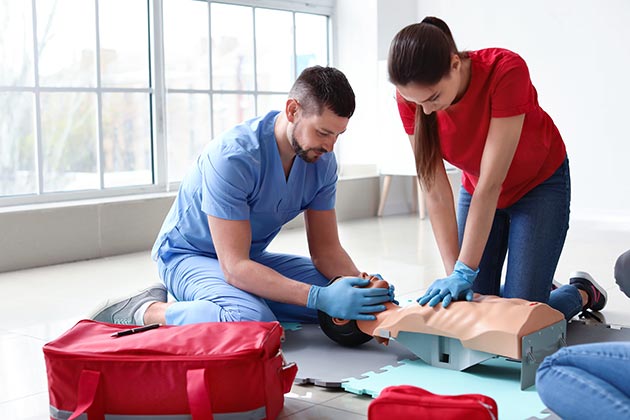The healthcare industry has placed equal importance on learning life saving skills, which in turn uphold the safety and security of any society. One of such courses happens to be Cardiopulmonary Resuscitation or CPR. Several online course providers allow individuals to opt for blended courses. Blended courses usually merge more than one lifesaving skills and comprehensively covers all the points required.
In this blog we will explore the sections of a CPR training course and will also gather insights on courses that provide first aid course training along with CPR.
Is it possible for a CPR course to accommodate modules on First Aid training too?
Certainly, many CPR courses are designed to incorporate modules on First Aid training, offering a comprehensive approach to emergency response education. Here’s how such courses can be structured:
- Introduction to CPR and First Aid Integration: The course begins with an overview of both CPR (Cardiopulmonary Resuscitation) and First Aid principles, highlighting their complementary roles in emergency care.
- Basic Life Support (BLS): Participants learn essential CPR techniques for adults, children, and infants, focusing on chest compressions, rescue breathing, and AED (Automated External Defibrillator) use.
- Airway Management: Training covers how to clear obstructed airways and provide effective ventilation, crucial skills in both CPR and First Aid scenarios.
- Recognition and Response to Emergencies: Participants are taught to recognize signs of various medical emergencies, such as cardiac arrest, choking, and severe allergic reactions, and to initiate appropriate responses.
- First Aid Skills: Modules on First Aid include wound care, bandaging techniques, splinting, burns management, and treatment for shock and bleeding.
- Integration Exercises: Hands-on scenarios and simulations integrate CPR and First Aid skills, allowing participants to practice their knowledge in realistic emergency situations.
- Teamwork and Communication: Emphasis is placed on effective teamwork and communication strategies, essential for coordinating care during emergencies involving both CPR and First Aid.
- Certification and Renewal: Upon successful completion, participants receive certification in both CPR and First Aid, typically valid for two years, with the option to renew through refresher courses.
By integrating CPR and First Aid training into a single course, participants gain a comprehensive skill set to confidently respond to a wide range of medical emergencies, ultimately enhancing their ability to save lives and provide critical care in various settings.
What should an ideal First Aid course cover?
An ideal First Aid course is designed to equip individuals with the knowledge and skills necessary to provide immediate assistance in medical emergencies. Here’s an overview of what such a course should cover:
- Introduction to First Aid: An overview of the importance of First Aid and its role in saving lives and preventing further injury or harm in emergency situations.
- Basic Life Support (BLS) and CPR: Instruction on performing high-quality CPR techniques for adults, children, and infants, including chest compressions, rescue breathing, and the use of automated external defibrillators (AEDs).
- Wound Care and Bandaging: Training on assessing and managing various types of wounds, including cuts, abrasions, punctures, and burns, as well as proper techniques for bandaging and dressing wounds.
- Fracture and Sprain Management: Education on recognizing and immobilizing fractures, dislocations, and sprains to prevent further injury and promote healing.
- Medical Emergencies: Modules covering common medical emergencies such as heart attacks, strokes, seizures, allergic reactions, diabetic emergencies, and heat-related illnesses, along with appropriate first aid interventions.
- Environmental Emergencies: Instruction on recognizing and responding to environmental emergencies, including hypothermia, heatstroke, frostbite, and dehydration.
- Poisoning and Toxic Exposure: Training on identifying signs of poisoning and toxic exposure, administering first aid measures, and seeking prompt medical assistance.
- Choking Management: Techniques for recognizing and responding to choking emergencies in adults, children, and infants, including the Heimlich maneuver and back blows.
- Emergency Action Plans: Guidance on developing and implementing emergency action plans for various settings, including homes, workplaces, schools, and recreational areas.
- Legal and Ethical Considerations: Discussion of legal and ethical aspects of providing First Aid, including consent, Good Samaritan laws, and documentation requirements.
- Practical Skills Practice: Hands-on practice with realistic scenarios and simulations to reinforce learning and build confidence in applying First Aid techniques.
Conclusion
A traditional CPR training course mostly focuses on teaching CPR (Cardiopulmonary Resuscitation). It may also include modules on first aid training. The whole purpose is to give students a more comprehensive emergency response education. Blended courses recognize the importance of critical lifesaving skills to be interconnected, to provide top-notch care, no matter what the emergency is.
By blending the modules of first aid and CPR training, participants can learn the skills of wound care, fracture management, and many other lifesaving techniques. This strategy ensures that students don’t just learn about cardiopulmonary resuscitation but also understand how to deal with other emergencies, which can arise out of nowhere.






